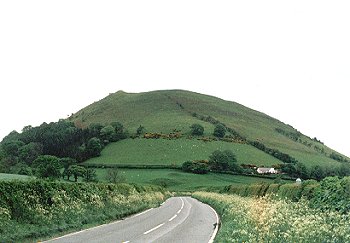
Cymraeg / English

|
Tanat Valley Historic Landscape |

|
Character area map |
Historic Landscape Characterisation
The Tanat Valley:
Llwyn Bryn-dinas, Llangedwyn, Powys
(HLCA 1000)
Steeply sloping hill land with rocky outcrops, prehistoric hillfort, and late 18th- to early 19th-century encroachment of commons, and areas of ancient semi-natural woodland and modern plantations.

Historic background
The character area falls within the medieval ecclesiastical parishes of Llangedwyn and Llanrhaeadr-ym-mochnant, with a small area within the parish of Llansilin, and formerly lay within the ancient commote of Mochnant Is Rhaeadr, Denbighshire.
The most prominent archaeological monuments in the character area are the spectacular hillfort on the summit of Llwyn Bryn-dinas where small-scale excavations have shown that its stone-revetted rampart was first constructed in the later Bronze Age, and that it was also occupied for at least periods during the Iron Age. The relationship of the hillfort with the smaller earthwork enclosure near Plas-uchaf in the adjacent character area of Llangedwyn is intriguing.
Key historic landscape characteristics
Diverse but topographically distinct area with predominantly west-facing slopes, and rising from a height of about 110m OD near the valley floor on the south, to the summit of Llwyn Bryn-dinas at 271m and the summit of Aran at 341m OD. Prominent shaley outcrops on the summit of Llwyn Bryn-dinas and along Craig Orllwyn. Natural upland lake in area of impeded drainage at Llyn Briw.
Llwyn Bryn-dinas itself is a prominent landmark within the valley, considered by George Borrow to be 'an exceedingly high and picturesque crag' (Wild Wales, 1862).
Settlement is largely limited to a number of widely-spaced probably post-medieval farms such as Wern-las and Tyn-y-graig, set in their own fields, and 19th-century stone farmhouse and outbuildings at Cilmawr, on the line of the public road, though there are early 19th-century cottage encroachments near Tyn-y-graig and in the area of Aran and Mynydd-y-briw, strung out along trackways and roadways, mostly near natural springs, the cottages being of quarried shale with brick dressings. Many of the least accessible cottages around Aran are now ruinous, most of the surviving one being on or near the made-up public road running northwards from Llangedwyn.
Areas of improved pasture on the gentler slopes and unimproved pasture elsewhere with patches or gorse. Relatively large and irregular fields over much of the area, with curving field boundaries indicating progressive and piecemeal woodland clearance, land improvement and enclosure probably largely during the 17th and 18th centuries, the older field boundaries marked by low field banks and with mixed species hedges and more recent boundaries by single species hawthorn hedges. Roadside hedges generally low-cut, many other hedges now overgrown though formerly laid. Some former boundaries marked by lynchets and lines of spaced shrubs, trees or tree-stumps, where a number of smaller fields have been run into one. Early 19th-century enclosure of common land on the sides of Llwyn Bryn-dinas and Craig Orllwyn marked by straighter boundaries at right-angles to the slope, in gridded fashion, with either single-species hedges, invariably of hawthorn, some of which are grown out, and some by post and wire fences, some of which have subsequently been abandoned. Drystone walls on boundaries between Llanrhaeadr-ym-mochnant, Llansilin and Llangedwyn parishes.
Small fields around Aran, associated with the early 19th-century cottage encroachment, with banks and lynchets indicating former ploughing. Hedges here now overgrown and seemingly deliberately planted with mixed species, including blackthorn, hazel, oak and hawthorn, some boundaries here having stone-revetted clearance banks.
Areas of semi-natural oak woodland and modern coniferous plantation on the steepest slopes, with scattered mature trees elsewhere.
Network of probably post-medieval lanes and footpaths links the farms, cottages and smallholdings, often along the contour or along a ridge, the public road running north from Llangedwyn partly running in a rock-cut hollow-way. Modern telecommunications mast near the summit of Aran.
Linear quarrying is visible across the western slopes of Llwyn Bryn-dinas, the purpose and dating of which is uncertain.
The cluster of cottages in the area of Mynydd-y-briw was served by a stone chapel with brick dressings built in 1894 and replacing an earlier structure of 1835.
Sources
Musson et al 1992For further information please contact the Clwyd-Powys Archaeological Trust at this address, or link to the Countryside Council for Wales' web site at www.ccw.gov.uk.
Privacy and cookies